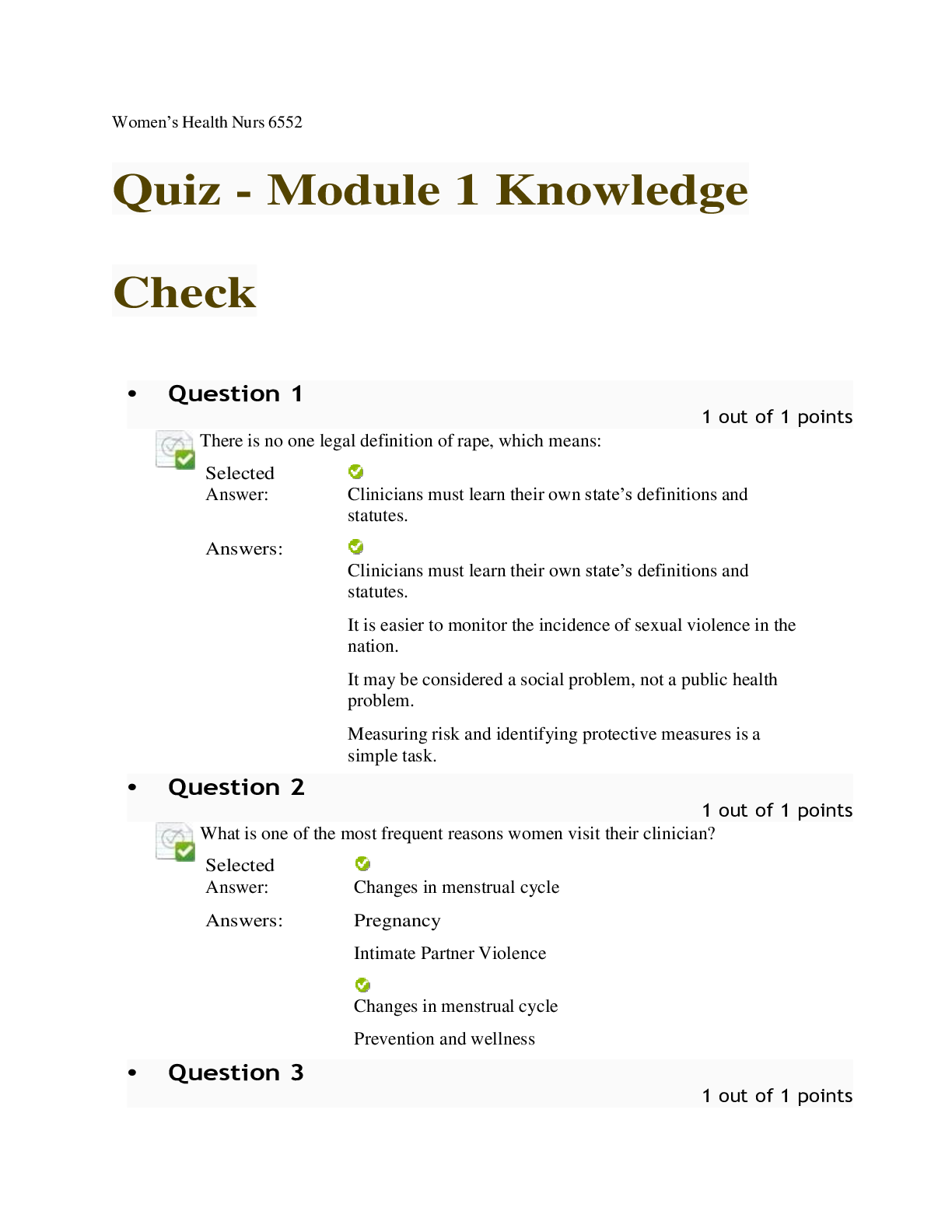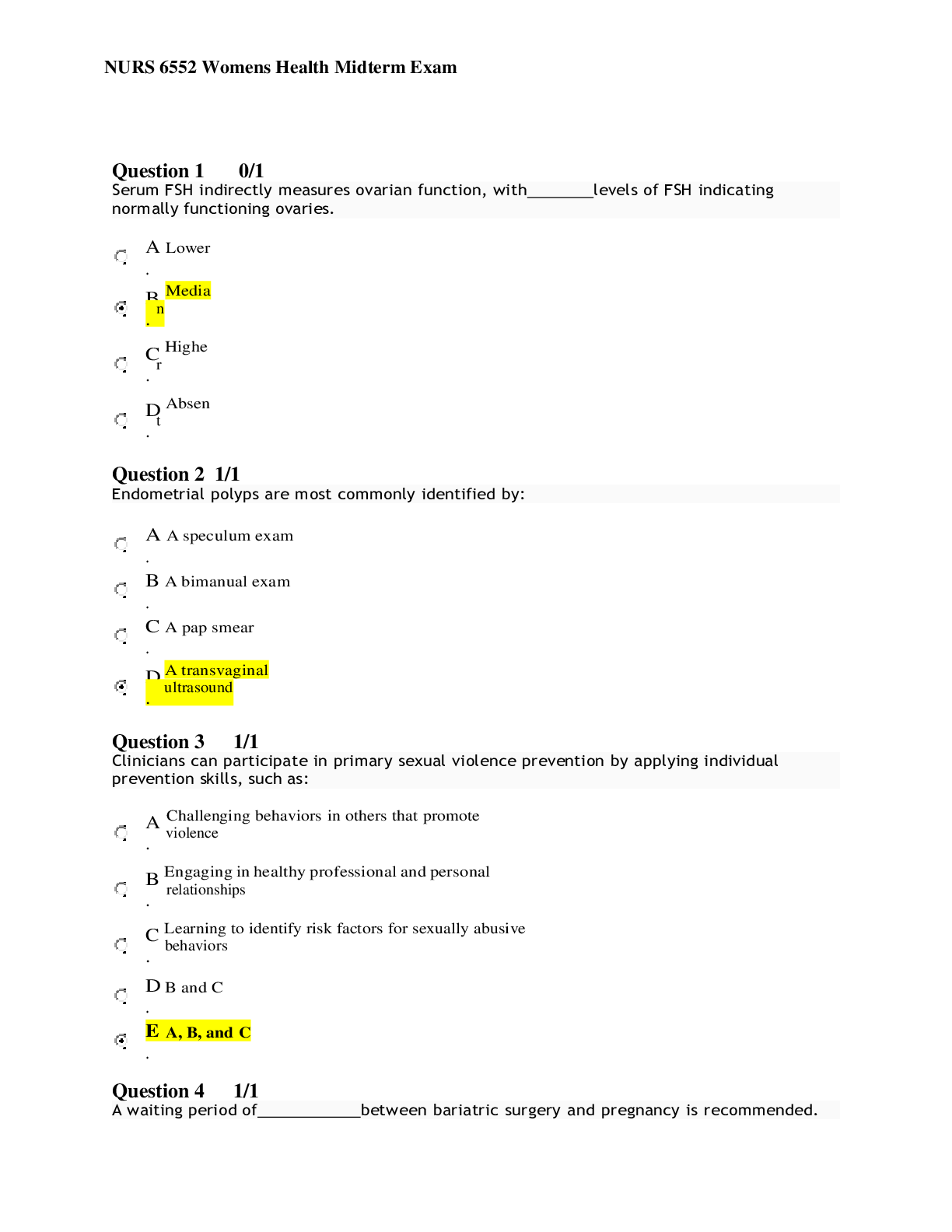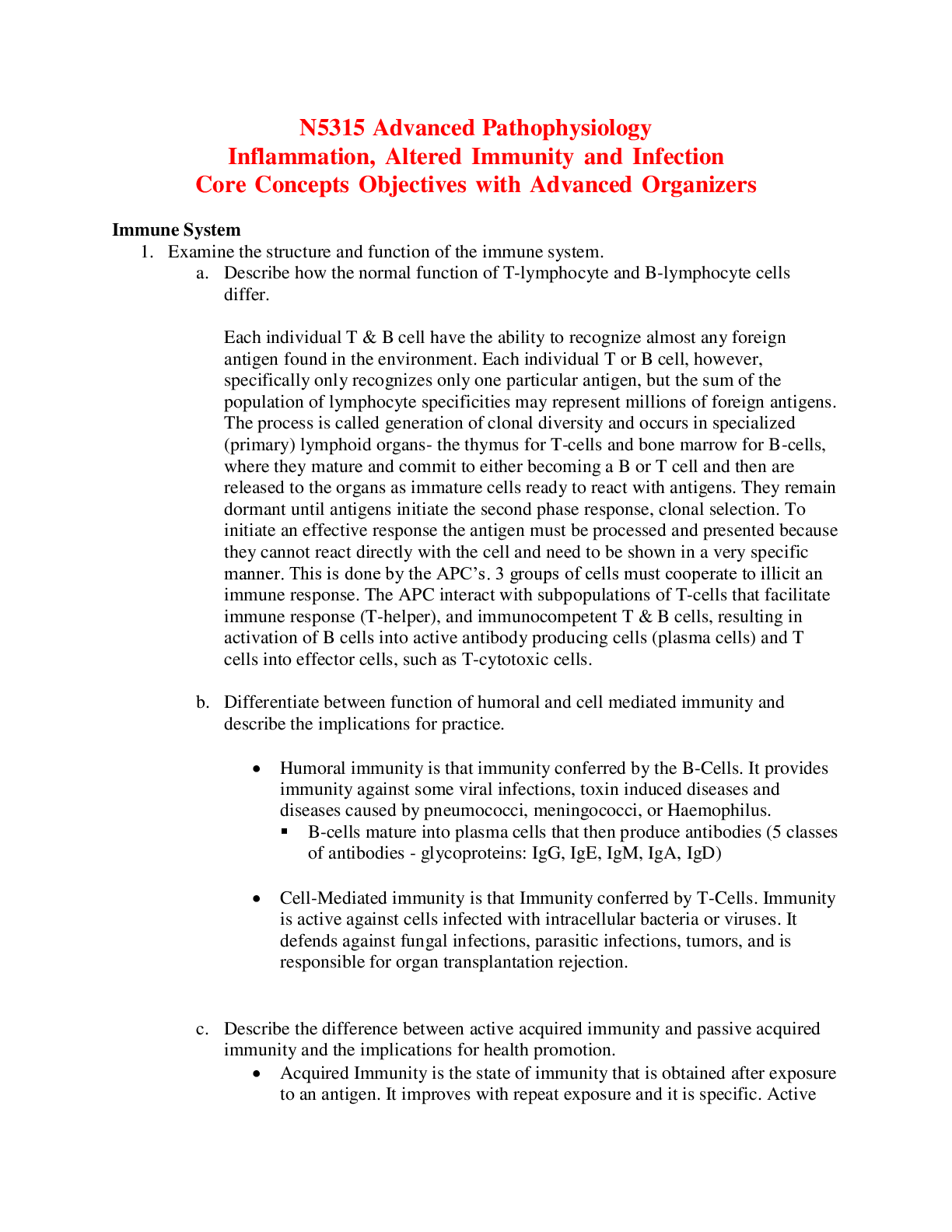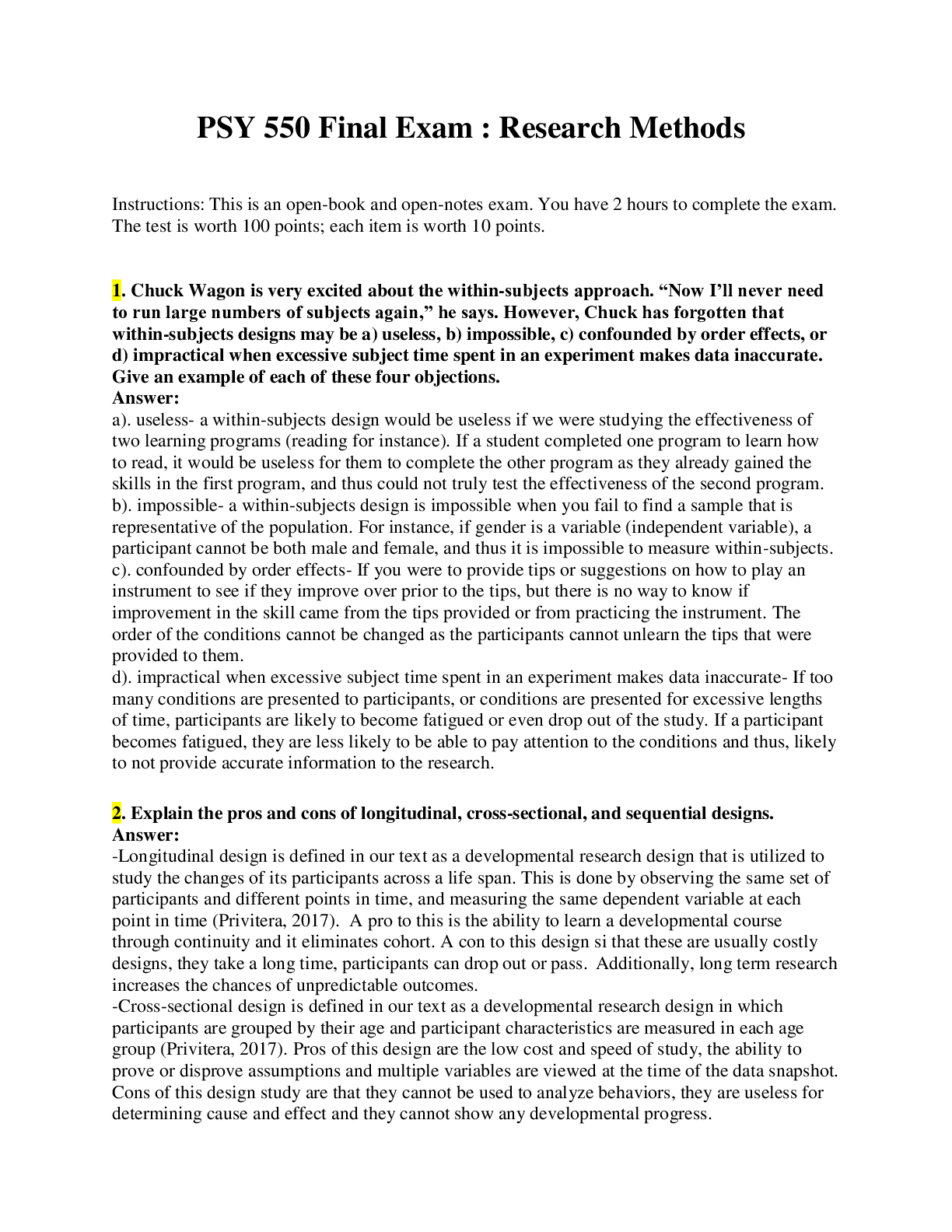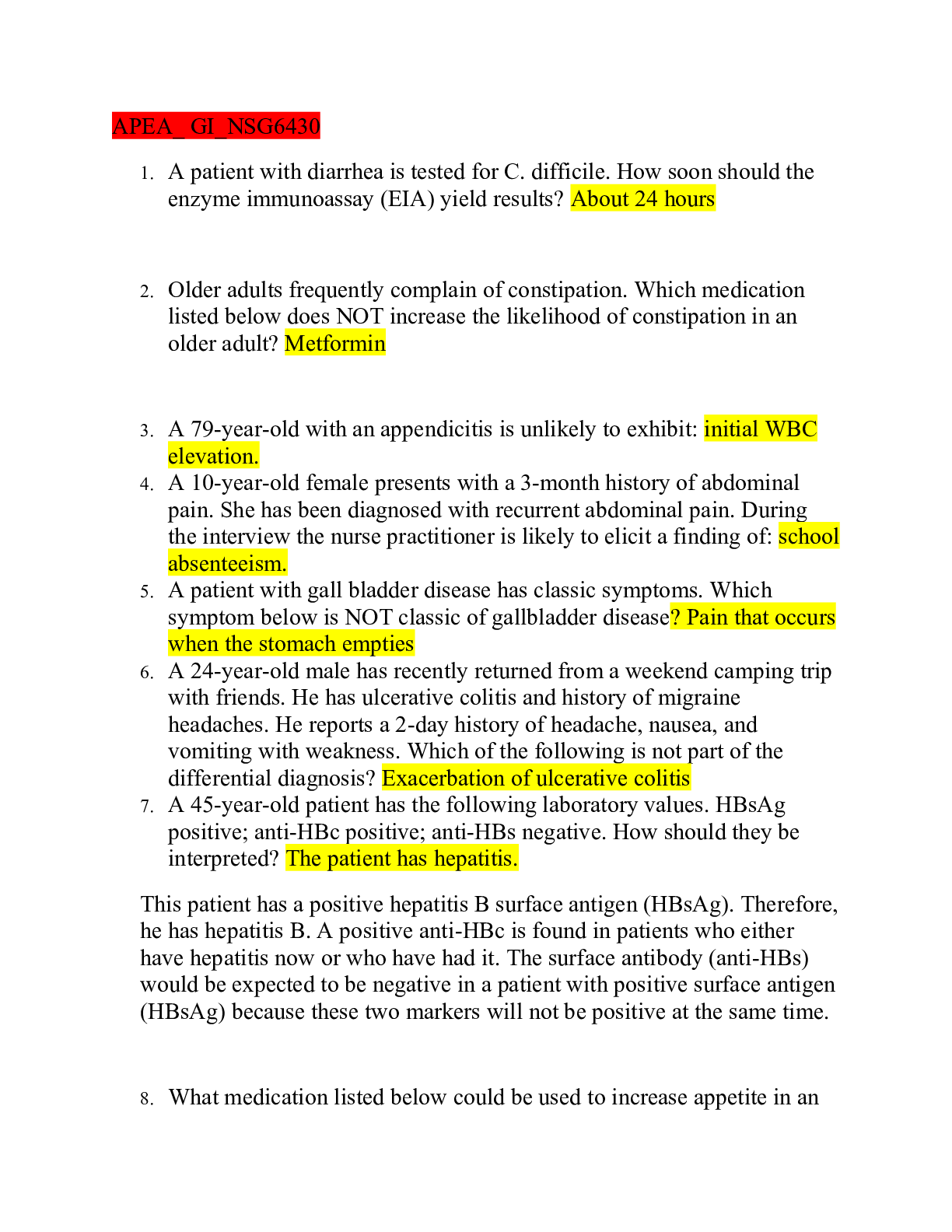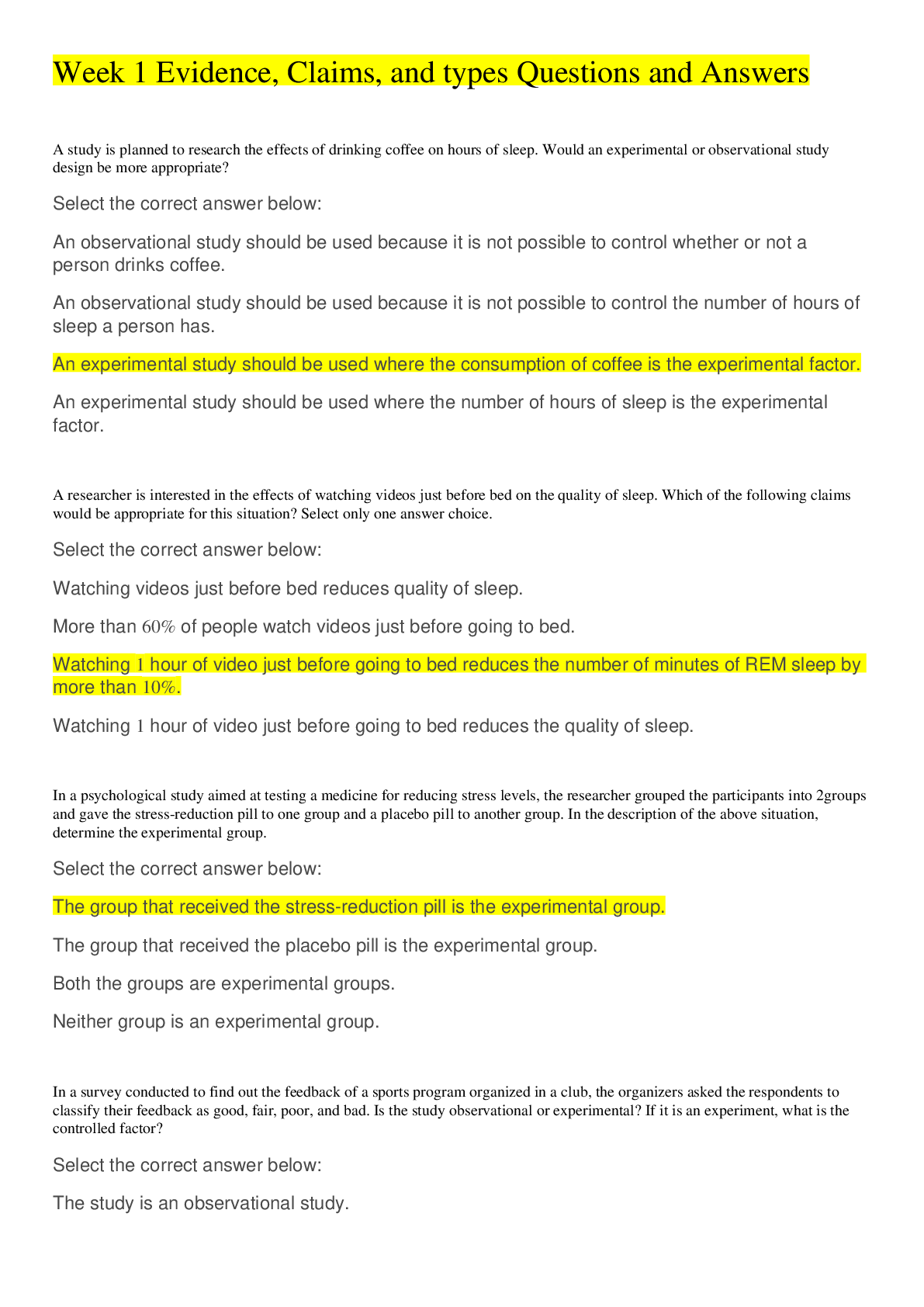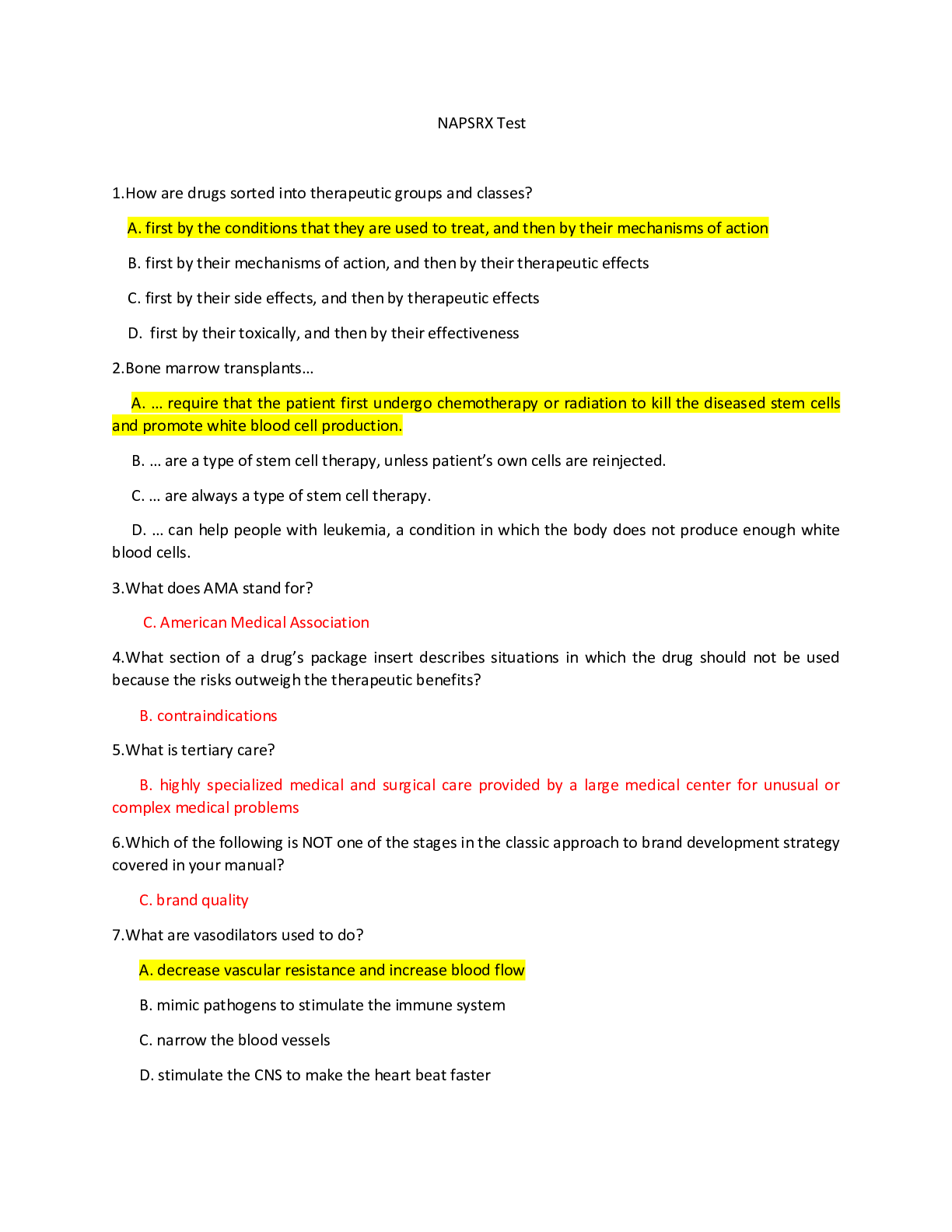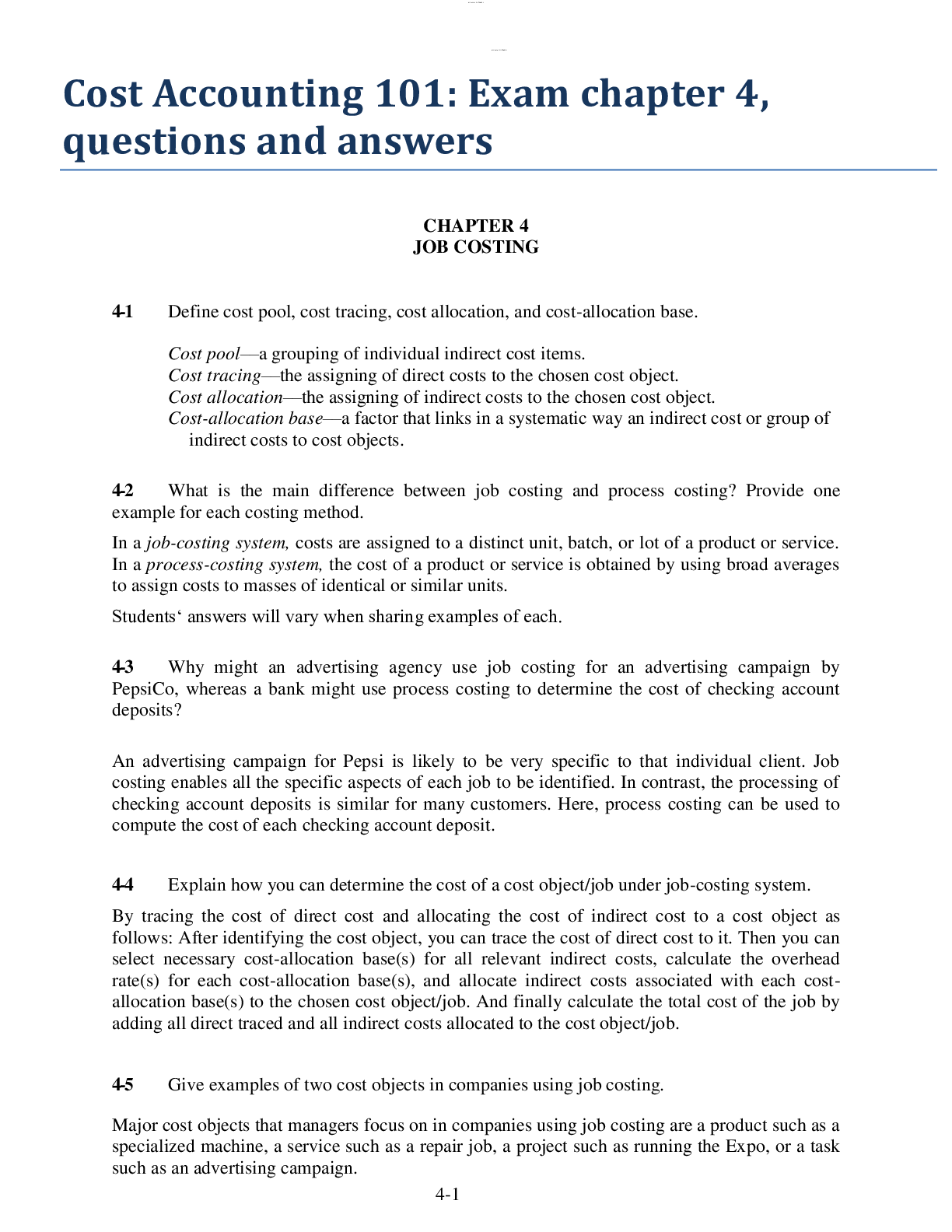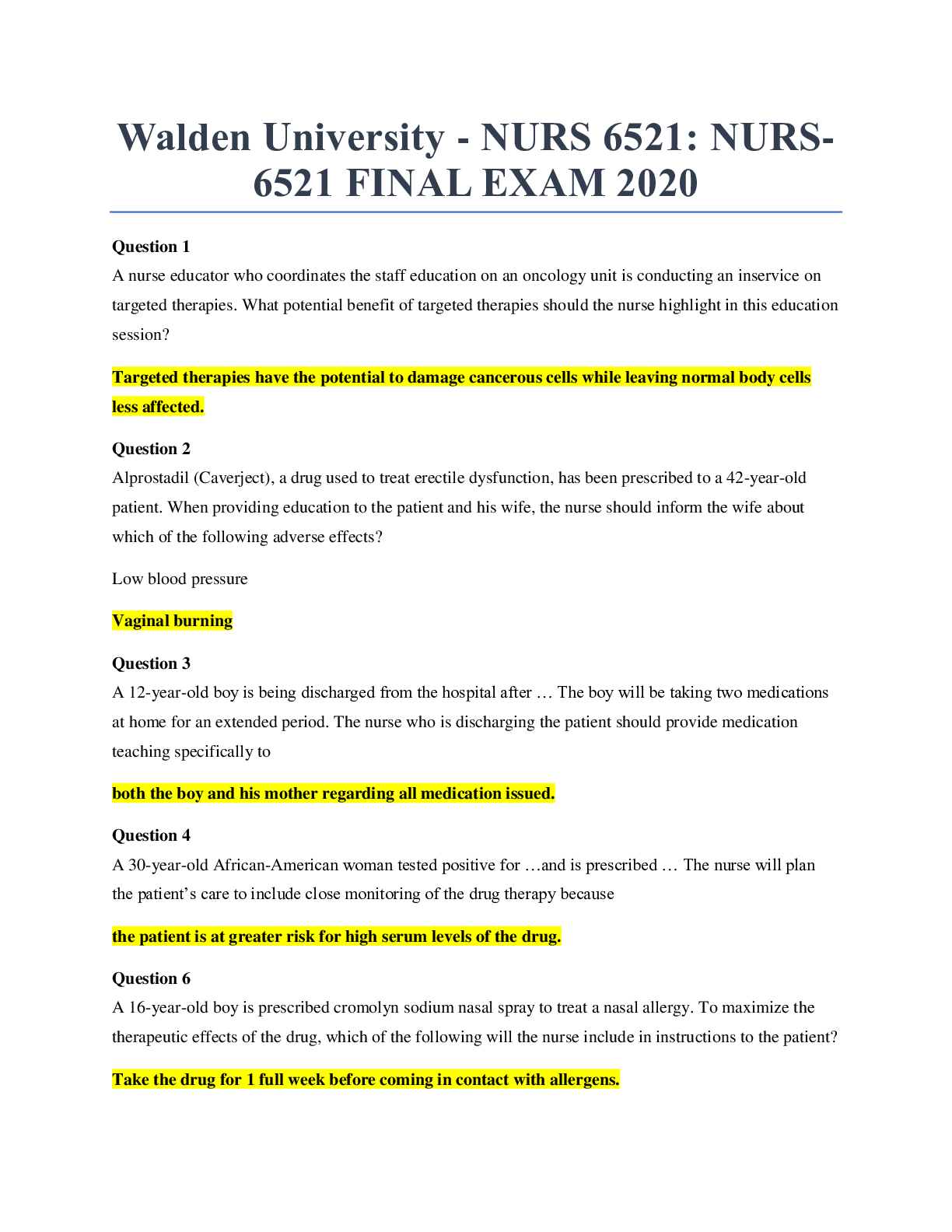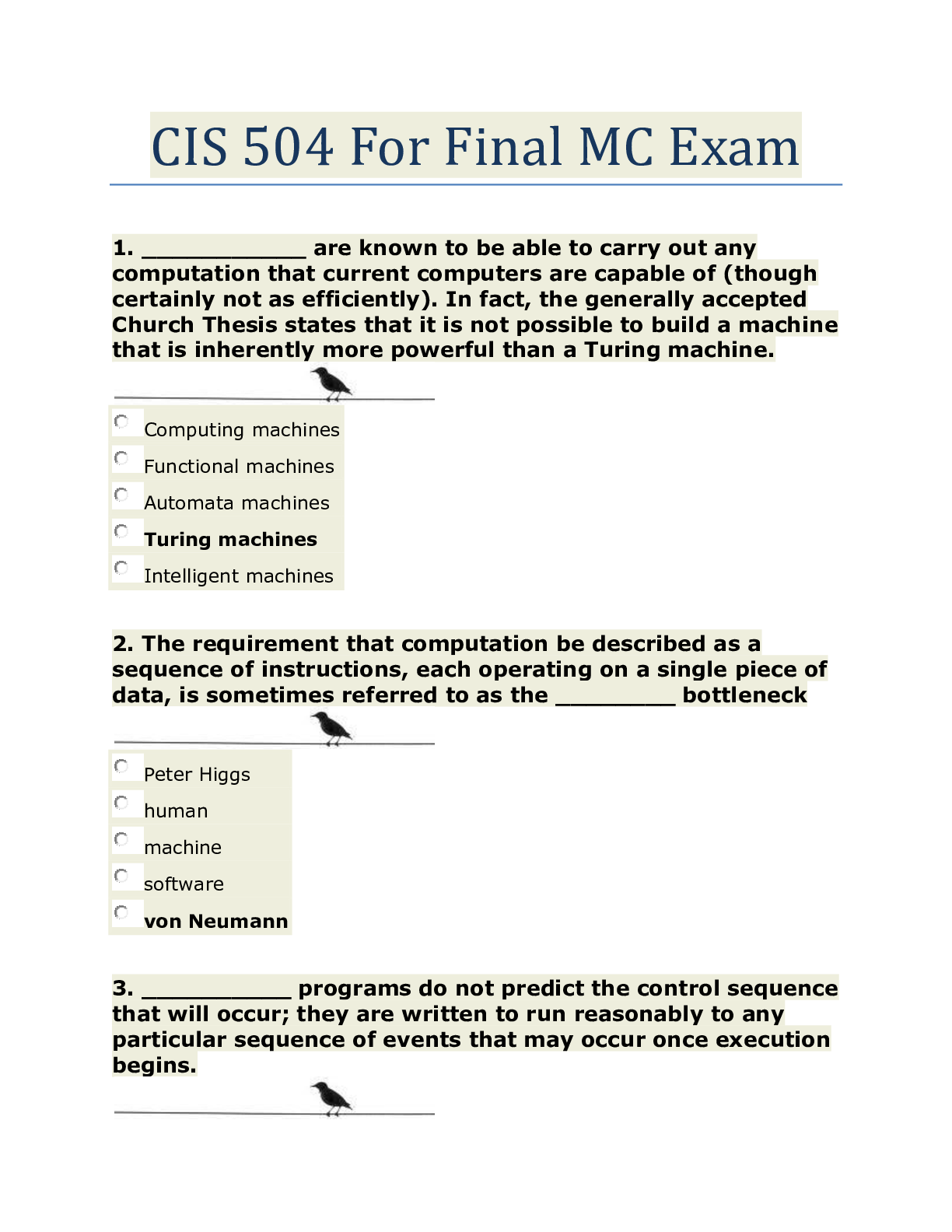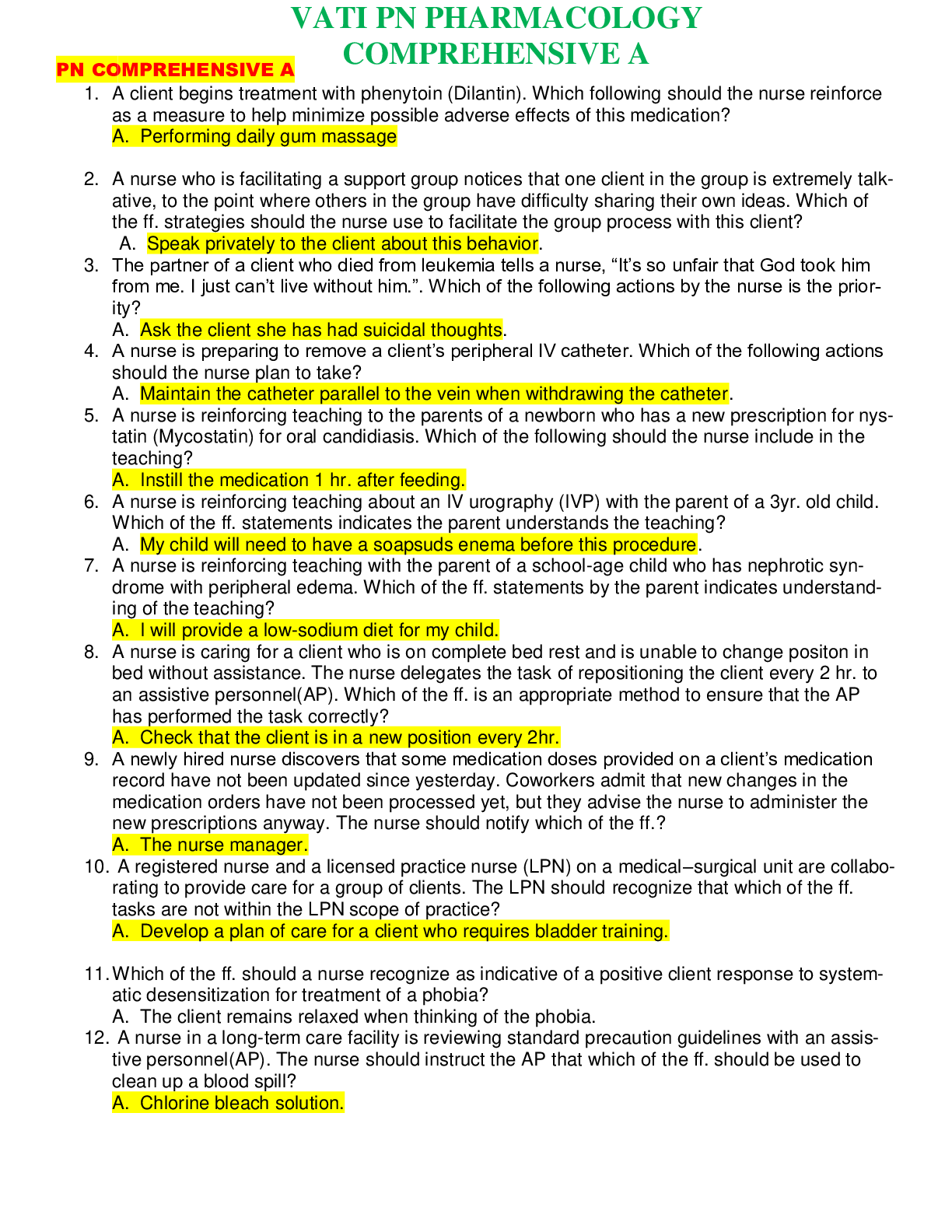*NURSING > EXAM > Primary Care: Art and Science of Advanced Practice Nursing - An Interprofessional Approach 5th editi (All)
Primary Care: Art and Science of Advanced Practice Nursing - An Interprofessional Approach 5th edition Dunphy Test . Top Grade Questions And Answers.
Document Content and Description Below
Primary Care: Art and Science of Advanced Practice Nursing - An Interprofessional Approach 5th edition Dunphy Test Bank Chapter 1. Primary Care in the Twenty-First Century: A Circle of Caring 1. A nur... se has conducted a literature review in an effort to identify the effect of handwashing on the incidence of nosocomial (hospital-acquired) infections in acute care settings. An article presented findings at a level of significance of <0.01. This indicates that A) the control group and the experimental group were more than 99% similar. B) the findings of the study have less than 1% chance of being attributable to chance. C) the effects of the intervention were nearly zero. D) the clinical significance of the findings was less than 1:100. Ans: B Feedback: The level of significance is the level at which the researcher believes that the study results most likely represent a nonchance event. A level of significance of <0.01 indicates that there is less than 1% probability that the result is due to chance. 2. A nurse has read a qualitative research study in order to understand the lived experience of parents who have a neonatal loss. Which of the following questions should the nurse prioritize when appraising the results of this study? A) How well did the authors capture the personal experiences of these parents? B) How well did the authors control for confounding variables that may have affected the findings? C) Did the authors use statistical measures that were appropriate to the phenomenon in question? D) Were the instruments that the researchers used statistically valid and reliable? Ans: A Feedback: Qualitative studies are judged on the basis of how well they capture and convey the subjective experiences of individuals. Statistical measures and variables are not dimensions of a qualitative methodology. 3. A nurse has expressed skepticism to a colleague about the value of nursing research, claiming that nursing research has little relevance to practice. How can the nurses colleague best defend the importance of nursing research? A) The existence of nursing research means that nurses are now able to access federal grant money, something that didnt use to be the case. B) Nursing research has allowed the development of masters and doctoral programs and has greatly increased the credibility of the profession. C) The growth of nursing research has caused nursing to be viewed as a true profession, rather than simply as a trade or a skill. D) The application of nursing research has the potential to improve nursing practice and patient outcomes. Ans: D Feedback: The greatest value of nursing research lies in the potential to improve practice and, ultimately, to improve patient outcomes. This supersedes the contributions of nursing research to education programs, grant funding, or the public view of the profession. 4. Tracy is a nurse with a baccalaureate degree who works in the labor and delivery unit of a busy urban hospital. She has noticed that many new mothers abandon breast-feeding their babies when they experience early challenges and wonders what could be done to encourage more women to continue breast-feeding. What role is Tracy most likely to play in a research project that tests an intervention aimed at promoting breast-feeding? A) Applying for grant funding for the research project B) Posing the clinical problem to one or more nursing researchers C) Planning the methodology of the research project D) Carrying out the intervention and submitting the results for publication Ans: B Feedback: A major role for staff nurses is to identify questions or problems for research. Grant applications, methodological planning, and publication submission are normally carried out by nurses who have advanced degrees in nursing. 5. A patient signed the informed consent form for a drug trial that was explained to patient by a research assistant. Later, the patient admitted to his nurse that he did not understand the research assistants explanation or his own role in the study. How should this patients nurse respond to this revelation? A) Explain the research process to the patient in greater detail. B) Describe the details of a randomized controlled trial for the patient. Health Promotion Multiple Choice Identify the choice that best completes the statement or answers the question. 1. Which of the following is a primary prevention measure for a 76-year-old man newly diagnosed with a testosterone deficiency? a. Calcium supplementation b. Testicular self-examination c. Bone density test d. Digital rectal examination 2. Which of the following is an example of secondary prevention in a 50-year-old woman? a. Yearly mammogram b. Low animal fat diet c. Use of seat belt d. Daily application of sunscreen 3. Which of the following is an example of tertiary prevention in a patient with chronic renal failure? a. Fluid restriction b. Hemodialysis 4 days a week c. High-protein diet d. Maintenance of blood pressure at 120/80 4. Immunizations are an example of which type of prevention? a. Primary b. Secondary c. Tertiary True/False Indicate whether the statement is true or false. 1. Prevalence is the number of new cases of a particular disease. 2. The number of cases of a particular disease for the past 5 years is an example of the incidence rate. 3. “There are 1,185,000 cases of HIV/AIDS in the United States” is an example of the morbidity rate. 4. Endemic is the term used when the presence of an event is constant. 5. The “bird” flu of 2005 to 2006 is considered a sporadic outbreak. 6. A pandemic affects many communities in a short period of time. Common Cardiovascular Complaints Multiple Choice Identify the choice that best completes the statement or answers the question. 1. Which group would most benefit from statins? a. Those with a low density lipoprotein-cholesterol greater than 100 mg/dL b. Individuals with clinical arteriosclerotic cardiovascular disease c. Individuals with a 10-year risk greater than 10% d. Individuals of all ages with diabetes mellitus (DM) 2. If chest pain can be alleviated with time, analgesics, and heat applications, what might the differential diagnosis be? a. Peptic ulcer b. Hiatal hernia c. Costochondritis d. Pericarditis 3. Sandra has palpitations that occur with muscle twitching, paresthesia, and fatigue. What specific diagnostic test might help determine the cause? a. Serum calcium b. Electrocardiogram (ECG) c. Thyroid-stimulating hormone test d. Complete blood cell count 4. A blood pressure (BP) of 150/90 is considered: a. Stage 2 hypertension b. Hypertensive c. Normal in healthy older adults d. Acceptable if the patient has DM 5. Lifestyle modifications to manage hypertension (HTN) include: a. Maintaining a body mass index of 17 b. Restricting dietary sodium to 2 grams per day c. Engaging in exercise or physical activity for 90 minutes a day d. Limiting beer intake to 24 ounces per day 6. Mary has hypertension and previously had a stroke. Which hypertensive drug would you order for her? a. Angiotensin converting enzyme inhibitor b. Calcium channel blocker c. Angiotensin II receptor blocker d. Beta blocker 7. Which high-density lipoprotein (HDL) level is considered cardioprotective? a. Greater than 30 b. Greater than 40 c. Greater than 50 d. Greater than 60 8. You are assessing Sigred for metabolic syndrome. Which of her parameters is indicative of this syndrome? a. Her waist is 36 inches. b. Her triglyceride level is 140 mg/dL. c. Her BP is 128/84. d. Her fasting blood sugar (BS) is 108 mg/dL. 9. Which type of angina do you suspect in Harvey, who complains of chest pain that occurs during sleep and most often in the early morning hours? a. Stable angina b. Unstable angina c. Variant (Prinzmetal’s angina) d. Probably not angina but hiatal hernia 10. Which ECG change is typical of cardiac ischemia? a. T-wave inversion b. ST-segment elevation c. Significant Q wave d. U-wave 11. In which type of arterioventricular (AV) block does the pulse rate (PR) interval lengthen until a beat is dropped? a. First-degree AV block b. Second-degree Mobitz I AV block c. Second-degree Mobitz II AV block d. Third-degree AV block 12. A Delta wave on the ECG may be present in which condition? a. Prinzmetal’s angina b. Bundle branch block c. Wolff-Parkinson-White syndrome d. Aortic stenosis 13. Which heart sound may be heard with poorly controlled hypertension, angina, and ischemic heart disease? a. A physiologic split S2 b. A fixed split S2 c. S3 d. S4 14. Samuel is going to the dentist for some work and must take endocarditis prophylaxis because of his history of: a. Severe asthma b. A common valvular lesion c. Severe hypertension d. A prosthetic heart valve 15. George, age 64, has cardiovascular disease (CVD), a total cholesterol of 280 mg/dL, and a systolic BP of 158. He is being treated for hypertension. You are doing a Framingham Risk Assessment on him. Which assessment factor would give him the highest number of points on the scale? a. His age b. His cholesterol level c. His systolic BP d. The fact that he is on antihypertensive medication 16. Which pain characteristic is usually indicative of cardiac pathology? a. Fleeting b. Moving c. Diffuse d. Localized 17. What percentage of patients with angina pectoris will have simultaneous dyspnea, caused by transient increase in pulmonary venous pressures that accompany ventricular stiffening during an episode of myocardial ischemia? a. About 20% b. About 30% c. About 50% d. Almost all 18. Nitroglycerine (NTG) is given for a patient having ischemic chest pain. One tablet or one spray should be used under the tongue every 5 minutes for three doses. What should be done if the pain has not been relieved after three doses? a. 911 should be called, and the patient should be transported immediately to the emergency department. b. One more dose of NTG may be tried. c. The person should be given two aspirin to chew. d. A portable defibrillator should be located to ascertain the cardiac rhythm. 19. For the best therapeutic effect after a myocardial infarction (MI), thrombolytics should be administered within the first 3 hours (ideally 30 minutes) of symptom onset. Studies have shown, however, that thrombolytic therapy can be of benefit up to how many hours after the initial presentation of MI symptoms? a. 6 hours b. 8 hours c. 10 hours d. 12 hours 20. When teaching post MI patients about their NTG tablets, the clinician should stress that the tablets should remain in the light-resistant bottle in which they are packaged and should not be put in another pill box or remain in areas that are or could become warm and humid. Once opened, the bottle must be dated and discarded after how many months? a. 1 month b. 3 months c. 6 months d. As long as the tablets are kept in this special bottle, they will last forever. 21. There are four stages of heart failure, classified as A to D, that describe the evolution and progression of disease. In which stage are patients hospitalized or treated with specialized interventions or hospice care for refractory symptoms of heart failure despite medical therapy? a. Stage A b. Stage B c. Stage C d. Stage D 22. Which of the following is abundant in the heart and rapidly rises in the bloodstream in the presence of heart failure, making it a good diagnostic test? a. B-type natriuretic peptide b. C-reactive protein c. Serum albumin d. Erythrocyte sedimentation rate 23. Which test has long been considered the gold standard for a diagnosis of venous thromboembolism? a. Ultrasound b. Magnetic resonance imaging (MRI) c. Ascending venogram d. D-dimer 24. Statins are approved for which age group? a. Children over the age of 2 b. Children over the age of 6 c. Children over the age of 10 d. Only adolescents and adults 25. The American College of Cardiology/American Heart Association states which of the following regarding the use of non-statin lipid-lowering agents? a. Nicotinic acid derivatives are effective for lowering LDL and triglycerides (TGs). b. Bile acid sequestrates increase HDL. c. Cholesterol absorption inhibitors decrease LDL. d. There is no sufficient evidence to use non-statin lipid-drugs. 26. Which of the following medications can cause hyperlipidemia? a. Diuretics b. NSAIDs c. Opioids d. Insulin 27. Jamie, age 55, has just started on a statin after having his liver function tests (LFTs) come back normal. He now asks you how often he has to have the LFTs repeated. What do you tell him? a. Initially in 6 weeks b. Every 3 months c. Every 6 months d. It’s no longer necessary for his statin regimen. 28. In the CHADS2 Index for the stroke risk score for AF, the ‘A’ stands for: a. Anticoagulation b. Autoimmune disease c. Age d. Antihypertension 29. Which murmurs are usually ‘watch and wait’? a. Systolic murmurs b. Diastolic murmurs c. They both are dangerous and need immediate attention. d. You can ‘watch and wait’ for both of them. 30. Which of the following statements about dabigatran is true? a. It is difficult to keep the patient in therapeutic range. b. Anticoagulation cannot be immediately reversed. c. It allows for the use of tPA if the patient has a stroke despite anticoagulation. d. None of the statements are true. 31. What value on the ankle-brachial index diagnoses peripheral artery disease? a. Less than 0.25 b. Less than 0.50 c. Less than 0.90 d. Greater than 1 32. Your patient with permanent afib asks when he can discontinue his warfarin. You tell him: a. When your internalized normalized ratio reaches 3.0, you can stop taking your warfarin permanently. b. When you no longer feel ill c. One month after your symptoms dissipate d. You’ll probably be on it indefinitely. 33. You just started Martha on HTN therapy. The Eighth Joint National Committee recommends that if her goal BP is not reached in what length of time, you should increase the initial drug or add a second drug to it? a. 1 month b. 3 months c. 6 months d. 1 year Palliative Care and Pain Management Multiple Choice Identify the choice that best completes the statement or answers the question. 1. Which of the following statements is true regarding pain? a. If a patient complains of pain but has no physical signs, he or she is most likely exhibiting drug-seeking behaviors. b. Acute pain is more intense and severe than chronic pain. c. Pain is a subjective experience related to actual or potential tissue damage. d. All of the above 2. Which of the following would be a cause of visceral pain? a. Bone metastases b. Intra-abdominal metastases c. Musculoskeletal inflammation d. Postsurgical incisional pain 3. According to the World Health Organization’s analgesic ladder, which drug combination would be most appropriate in an opiate-naïve patient who presents with moderate pain? a. Ibuprofen/imipramine b. Naproxen/morphine c. Aspirin/fentanyl d. Indomethacin/hydrocodone 4. A 75-year-old man is being treated as an outpatient for metastatic prostate cancer. Which of the following statements is true regarding the management of pain with opioids in the elderly? a. Opioids with a long half-life, such as methadone, are a good choice, because they stay in the system longer, and patients do not have to remember to take multiple pills. b. Serum creatinine is the best measurement of renal function in the elderly and should be done prior to the initiation of treatment with opioids. c. Renal clearance of medications is faster in the elderly, so higher dosages of medications are needed to adequately control pain. d. None of the above 5. A patient had a transdermal fentanyl patch placed 2 hours ago and is not getting any pain relief. What would be the most appropriate intervention? a. Remove the current patch and replace with a new fentanyl patch at a higher dose. b. Prescribe a short-acting opioid for breakthrough pain. c. Remove the patch and switch to a different intravenous opioid. d. Tell the patient not to worry, as it takes about 12 hours for the patch’s effects to be felt, and he will have relief at that time. 6. A patient is preparing to be discharged to home with hospice. She is on a morphine patient- controlled analgesia (PCA) in the hospital. She is concerned as to whether she can stay on her morphine PCA at home even when she is not able to give herself boluses. What would be an appropriate response from the clinician? a. “We are unable to prescribe a PCA for use at home. If you are comfortable on the PCA, you should remain in the hospital.” b. “It would be possible for your nurse or another trained family member to activate the dosing button when you are unable to do so.” c. “A PCA is not an appropriate method of pain medication delivery once you are unable to use the dosing button. I will switch you to another form of pain control.” d. “You should not be concerned about your pain management at home. It will be taken care of for you.” 7. A patient taking PO hydromorphone for pain control has developed dysphagia. The clinician decides to switch the patient to IV hydromorphone. What ratio of IV:PO hydromorphone does the clinician need to know to calculate the proper dose? a. 1:1 b. 1:2 c. 1:5 d. 1:7 8. A patient is receiving long-acting oxycodone for pain control. The clinician thinks that he also will benefit from a short-acting oxycodone for breakthrough pain. How will the clinician figure out what the dose of short-acting oxycodone should be? a. The short-acting dose should be 10% to 20% of the total 24-hour long-acting dose. b. The short-acting dose should be 40% to 50% of the total 24-hour long-acting dose. c. The short-acting dose should be 10% to 20% of each long-acting dose. d. The short-acting dose should be 40% to 50% of each long-acting dose. 9. A patient is being switched from hydromorphone to methadone in an attempt to achieve better pain control. How much should the dose of methadone be reduced when calculating the equianalgesic dose of the two drugs? a. 0% b. 20% c. 50% d. 90% 10. If a patient requires six rescue doses for breakthrough pain in a 24-hour period, what would be an appropriate intervention? a. Increase the dose of the baseline long-acting medication. b. Increase the dose of the rescue short-acting medication. c. Switch to a different short-acting rescue medication. d. Do nothing, because this is appropriate, and the patient’s pain is well controlled. 11. A patient with bone metastases from prostate cancer inquires whether he is a candidate for radiopharmaceuticals. Which of the following conditions would exclude him as a candidate? a. Karnofsky performance status of 65 b. Pathologic fracture c. Life expectancy of 5 months d. Hypocalcemia 12. Which of the following is the best description of dyspnea? a. An oxygen saturation of less than 90% b. Respiratory rate greater than 24 c. A psychological state resulting in the feeling of air hunger d. A subjective feeling of breathlessness 13. What would be an appropriate dose of morphine to give an opioid-naïve patient to manage tachypnea associated with dyspnea? a. 5 mg PO every 4 hours b. 15 mg PO every 4 hours c. 30 mg PO every 4 hours d. 40 mg PO every 4 hours 14. Glycopyrrolate (Robinul) is one drug of choice to manage which of the following conditions that can contribute to dyspnea? a. Copious secretions b. Cough c. Anxiety d. Effusion 15. Which characteristic of delirium helps to distinguish it from dementia? a. Abrupt onset b. Impaired attention c. Affective changes d. Delusions 16. Which of the following classes of drugs should be used as first-line therapy for treatment of delirium? a. Benzodiazepines b. Antipsychotics c. Anticonvulsants d. Antidepressants 17. Which of the following is a role of the advanced practice nurse in palliative cancer care? a. Detecting cancer in asymptomatic patients or those with specific symptoms b. Arranging for follow-up care, including psychosocial and spiritual support c. Identifying and managing complications of care d. All of the above True/False Indicate whether the statement is true or false. 1. Patients who are receiving life-prolonging therapies do not qualify for palliative care. 2. Some anticonvulsant drugs can be used as an adjuvant treatment for mild pain. 3. Oxygen has shown no benefit in alleviating dyspnea in patients without hypoxemia. Prostate Disorders Multiple Choice Identify the choice that best completes the statement or answers the question. 1. A 63-year-old man is seen in the clinic with a chief complaint of nocturia. Which of the following should be included in the differential diagnosis? a. Psychogenic nocturia b. Urethral polyp c. Irritative posterior urethral lesion d. Benign prostatic hypertrophy 2. A 76-year-old man is seen in the office for complaints of urinary incontinence. The clinician should explore which of these causes of incontinence in men? a. Urethral polyps b. Urinary tract infection (UTI) c. Anticholinergic medication d. All of the above 3. A 14-year-old male is seen with complaints of severe testicular pain. The clinician suspects testicular torsion. Which of the following is the appropriate action? a. Refer to a urologist immediately. b. Obtain a computed tomography (CT) scan. c. Instruct the patient to elevate the scrotum. d. Prescribe ibuprofen. 4. An 82-year-old man is seen in the primary care office with complaints of dribbling urine and difficulty starting his stream. Which of the following should be included in the list of differential diagnoses? a. Benign prostatic hyperplasia (BPH) b. Parkinson’s disease c. Prostate cancer d. All of the above 5. Which of the following would be an appropriate treatment for a patient with mild BPH? a. Refer to a urologist for surgery. b. Prescribe a trial of tamsulosin. c. Recommend cranberry supplements. d. Reevaluate symptoms in 1 to 3 months. 6. A 30-year-old man is seen with a chief complaint of loss of libido. Which of the following laboratory tests would help establish a diagnosis? a. Testosterone level b. Prostate-specific antigen c. Nocturnal penile tumescence and rigidity d. Prolactin level 7. Which of the following should be considered in a patient presenting with erectile dysfunction? a. Diabetes mellitus b. Hypertension c. Atherosclerosis d. All of the above 8. A 35-year-old man presents with complaints of painful erections, and he notices his penis is crooked when erect. What is the most likely diagnosis? a. Peyronie’s disease b. Damage to the pudendal artery c. Scarring of the cavernosa d. All of the above 9. The patient with BPH is seen for follow-up. He has been taking finasteride (Proscar) for 6 months. The clinician should assess this patient for which of these side effects? a. Erectile dysfunction b. Glaucoma c. Hypotension d. Headache 10. The clinician should prescribe an antibiotic that covers which of these organisms for a patient with acute prostatitis? a. Gram-positive cocci b. Gram-negative cocci c. Gram-positive bacillus d. Gram-negative bacillus 11. The 56-year-old man with chronic prostatitis should be treated with trimethoprim 80 mg- sulfamethoxazole 400 mg (TMP-SMX, Bactrim) for how long? a. 3 to 7 days b. 14 to 21 days c. 3 to 6 weeks d. 6 to 12 weeks 12. A 46-year-old man presents with urinary hesitancy and low back pain. He has no history of UTI. Digital rectal examination (DRE) reveals a normal prostate, and a diagnosis of prostatodynia is made. Which is the appropriate treatment? a. Terazosin 2 mg PO once a day b. Ice pack to the scrotal area c. Saw palmetto 320 mg per day d. All of the above 13. A 23-year-old sexually active man is seen in the clinic with unilateral painful testicular swelling, and he is diagnosed with epididymitis. In order to prescribe the correct drug, the clinician must understand that which of these is the most common causative organism? a. Escherichia coli b. Staphylococcus aureus c. Chlamydia trachomatis d. Pseudomonas aeruginosa 14. Which test is used to confirm a diagnosis of epididymitis? a. Urinalysis b. Gram stain of urethral discharge c. Complete blood cell count with differential d. Ultrasound of the scrotum 15. Treatment for epididymitis includes which of the following? a. Warm sitz baths b. Scrotal elevation c. Masturbation d. All of the above 16. Which of the following data is indicative of testicular torsion? a. Absent cremasteric reflex b. Pain relieved on testicular elevation c. Testicle very low in the scrotum d. Swollen scrotum with “red dot sign” 17. A 60-year-old man presents with an enlarged scrotum. The clinician uses a penlight to transilluminate the scrotum. In a patient with a hydrocele, what would the clinician expect to find? a. The scrotum will be dark. b. The scrotum will appear light pink or yellow. c. The scrotum will appear milky white. d. The internal structures will be clearly visible. 18. During a DRE on a 75-year-old man, the clinician suspects the patient has prostate cancer. What physical finding should make the clinician suspicious? a. An enlarged rubbery gland b. A hard irregular gland c. A tender gland d. A boggy gland 19. A 78-year-old man is diagnosed with C2 prostate cancer, and he asks the clinician what that means. In order to answer the patient, the clinician must have which of these understandings of the Jewett rating system? a. The cancer involves the seminal vesicles. b. There is metastatic disease to regional lymph nodes. c. The cancer is confined to the capsule. d. There is metastasis to distant organs. 20. A 58-year-old patient has been receiving leuprolide as treatment for prostate cancer. The clinician should instruct the patient about which of these side effects? a. Risk of osteoporosis b. May have hot flushes c. May have impotence d. All of the above 21. A 22-year-old male is seen in the clinic because he found a hard lump in his testicle when performing testicular self-examination (TSE). Which of the following should be included in the list of differential diagnoses? a. Testicular cancer b. Inguinal hernia c. Varicocele d. All of the above 22. What is the treatment of choice for a patient diagnosed with testicular cancer? a. Radical orchidectomy b. Lumpectomy c. Radiation implants d. All of the above 23. A patient with testicular cancer is being followed after completing treatment 1 year ago. He has been symptom-free with no evidence of disease. How often should he have a CT scan? a. Every month b. Every 3 to 4 months c. Every 6 to 12 months d. Every year True/False Indicate whether the statement is true or false. 1. Patients treated for Neisseria gonorrhoeae also should be treated for Chlamydia trachomatis. 2. Hepatitis A is considered a sexually transmitted infection by the Centers for Disease Control and Prevention. Vaginal, Uterine, and Ovarian Disorders Multiple Choice Identify the choice that best completes the statement or answers the question. 1. A 23-year-old sexually active woman presents for her first Pap smear. Her history includes nulligravida, age at first intercourse 14, and more than 10 sexual partners. Which of the following conditions should the clinician be particularly alert for during her examination? a. Human papillomavirus (HPV) b. Endometrial hyperplasia c. Vagismus d. Polycystic ovarian syndrome 2. A 20-year-old woman is seen in the clinic because her boyfriend was found to have gonorrhea. Which of the following is the treatment of choice for gonorrhea? a. Ceftriaxone b. Doxycycline c. Acyclovir d. Metronidazole 3. A 24-year-old woman presents to the clinic with dysuria, dyspareunia, and a mucopurulent vaginal discharge. Her boyfriend was recently treated for nongonococcal urethritis. What sexually transmitted disease has she most probably been exposed to? a. Gonorrhea b. HPV c. Chlamydia d. Trichomonas 4. A 45-year-old woman is seen in the clinic with complaints of a vaginal discharge. The clinician identifies clue cells on the vaginal smear. Which of the following diagnoses is associated with this finding? a. Trichomonas b. Bacterial vaginosis c. HPV d. Herpes simplex virus 5. Which of the following medications is the treatment of choice for trichomonas? a. Metronidazole b. Ceftriaxone c. Diflucan d. Doxycycline 6. A 58-year-old woman presents with a breast mass. Which of the following responses by the clinician would be most appropriate? a. “It is probably just a cyst because that is the most common breast mass.” b. “We will order a mammogram and ultrasound to help establish a diagnosis.” c. “We will go ahead and schedule you for a biopsy because that is the only way to know for sure.” d. “Because your lump is painful, it is most likely not cancer.” 7. A 26-year-old woman is seen with complaints of irregular vaginal bleeding. Which of the following tests should be the first priority? a. Pregnancy test b. Pelvic ultrasound c. Endometrial biopsy d. Platelet count 8. A 42-year-old woman presents to the clinic with complaints of painful intercourse for the last month. Which of the following should be explored as the likely cause of her dyspareunia? a. Menopause b. Dehydration c. Excess progesterone d. Sexual trauma as a child 9. A 36-year-old woman is seen with complaints of vaginal itching, burning, and discharge. On potassium hydroxide (KOH) wet mount of vaginal discharge, the clinician notices hyphae. Which of the following treatments would be appropriate? a. Fluconazole b. Estrogen vaginal cream c. Metronidazole d. Doxycycline 10. A 21-year-old woman is seen in the clinic requesting birth control pills. Which of the following tests is essential before prescribing any oral contraceptive? a. Pregnancy test b. Complete blood cell count c. Thyroid-stimulating hormone d. Urine dip for protein 11. A 40-year-old woman is seen for her yearly examination. She is single and not in a monogamous relationship. Her social history includes smoking cigarettes “occasionally” and drinking about two beers a day. Her body mass index (BMI) is 25. She is requesting birth control. Which of the following methods would be best for this patient? a. Intrauterine device b. Oral contraceptive c. Condom d. Vaginal contraceptive sponge 12. A 44-year-old patient with breast cancer is prescribed tamoxifen by her surgeon. She is complaining about hot flashes. Which of the following responses by the clinician would be most appropriate? a. “You must be having menopause.” b. “The hot flashes are a result of the antiestrogenic effects of tamoxifen.” c. “Tamoxifen will impact your temperature regulation center.” d. “The drug destroys your ovaries.” 13. A 32-year-old woman is seen in the clinic because she has been unable to get pregnant after 12 months of unprotected sex. In order to determine the cause of the infertility, the clinician should question her about which of these possible causes? a. Pelvic inflammatory disease b. Oral contraceptive use for 15 years c. Early menarche d. Diet high in soy protein 14. When assessing a woman for infertility, which of the following tests should be done first? a. Analysis of partner’s sperm b. Magnetic resonance imaging (MRI) c. Hysterosalpingogram d. Estrogen level 15. A 15-year-old girl is seen in the clinic because she has not yet had her first period. Which of the following questions would help the clinician determine the cause? a. “Are you sexually active?” b. “How long have you been underweight?” c. “Did your mother take diethylstilbestrol during her pregnancy?” d. “Have you noticed any changes in your moods lately?” 16. What is the most common cause of secondary amenorrhea? a. Pregnancy b. Pituitary dysfunction c. Inadequate estrogen levels d. Genetic disorders 17. A 22-year-old woman is diagnosed with premenstrual syndrome. Which of the following lifestyle changes should the clinician suggest to help minimize the patient’s symptoms? a. At least 4 cups of green tea daily b. Regular exercise c. Take vitamin A supplements d. Eat a diet high in iron 18. A 25-year-old woman is seen in the clinic complaining of painful menstruation. Which of the following pelvic pathologies is the most common cause of dysmenorrhea? a. Pelvic inflammatory disease b. Endometriosis c. Sexually transmitted infections d. Ovarian cyst 19. A 26-year-old woman tells the clinician that she has endometriosis, because she has frequent pelvic pain. The clinician also should consider which of these differential diagnoses? a. Diverticulitis b. Cholelithiasis c. Kidney stones d. Ovarian cysts 20. Which of the following would be appropriate treatment for a woman with mild endometriosis? a. Oral contraceptives b. Leuprolide acetate injections c. Nafarelin nasal spray d. Hysterectomy 21. A 45-year-old woman is seen in the clinic with abnormal uterine bleeding and pain during intercourse. The clinician should consider which of the following diagnoses? a. Leiomyoma b. Pregnancy c. Ovarian cancer d. All of the above 22. A 48-year-old woman is seen in the clinic with complaints of prolonged heavy menstrual periods. She is pale and states she can no longer exercise. Pelvic exam reveals a single, very large mass. Which of the following diagnostic tests should the clinician order first? a. Transvaginal ultrasound b. Endometrial biopsy c. MRI d. Abdominal computed tomography scan 23. A 45-year-old woman is seen because of irregular menstrual periods. Her follicle-stimulating hormone (FSH) level is 48 mIU/mL, and her luteinizing hormone (LH) level is elevated. She asks the clinician what this means. Which would be the best response? a. “You are approaching menopause.” b. “You have a hormonal imbalance.” c. “Your FSH is normal, but your pituitary is making too much LH.” d. “There is an imbalance between your ovaries and pituitary.” 24. Which of the following tests is essential for a 46-year-old woman who the clinician suspects is perimenopausal? a. Pregnancy b. Estrogen level c. Progesterone level d. LH level 25. A 60-year-old woman is seen for an annual checkup. Her obstetric history reveals para 6, gravida 6. She reports that she went through menopause at age 45. Her grandmother died at age 80 of colon cancer, and her father died of lung cancer. What in her history would be a risk factor for ovarian cancer? a. Her numerous pregnancies b. Her age at menopause c. Her father’s history of lung cancer d. Her grandmother’s history of colon cancer 26. A 58-year-old woman, who had a total abdominal hysterectomy at the age of 45, is diagnosed with atrophic vaginitis. Which of the following is the most appropriate treatment? a. Conjugated estrogen, 0.625 mg/day oral b. Estradiol, 7.5 mcg/24 hr vaginal ring c. Medroxyprogesterone, 10 mg/day oral d. Conjugated estrogen, 0.3 mg + medroxyprogesterone 1.5 mg/day oral True/False Indicate whether the statement is true or false. 1. Oral contraceptive pills can cause endometrial cancer. 2. A woman taking estradiol is at risk for developing endometrial cancer. 3. Most breast cancer cases are in women with a family history of breast cancer. [Show More]
Last updated: 1 year ago
Preview 1 out of 530 pages
Instant download

Buy this document to get the full access instantly
Instant Download Access after purchase
Add to cartInstant download
Reviews( 0 )
Document information
Connected school, study & course
About the document
Uploaded On
Mar 29, 2021
Number of pages
530
Written in
Additional information
This document has been written for:
Uploaded
Mar 29, 2021
Downloads
0
Views
42

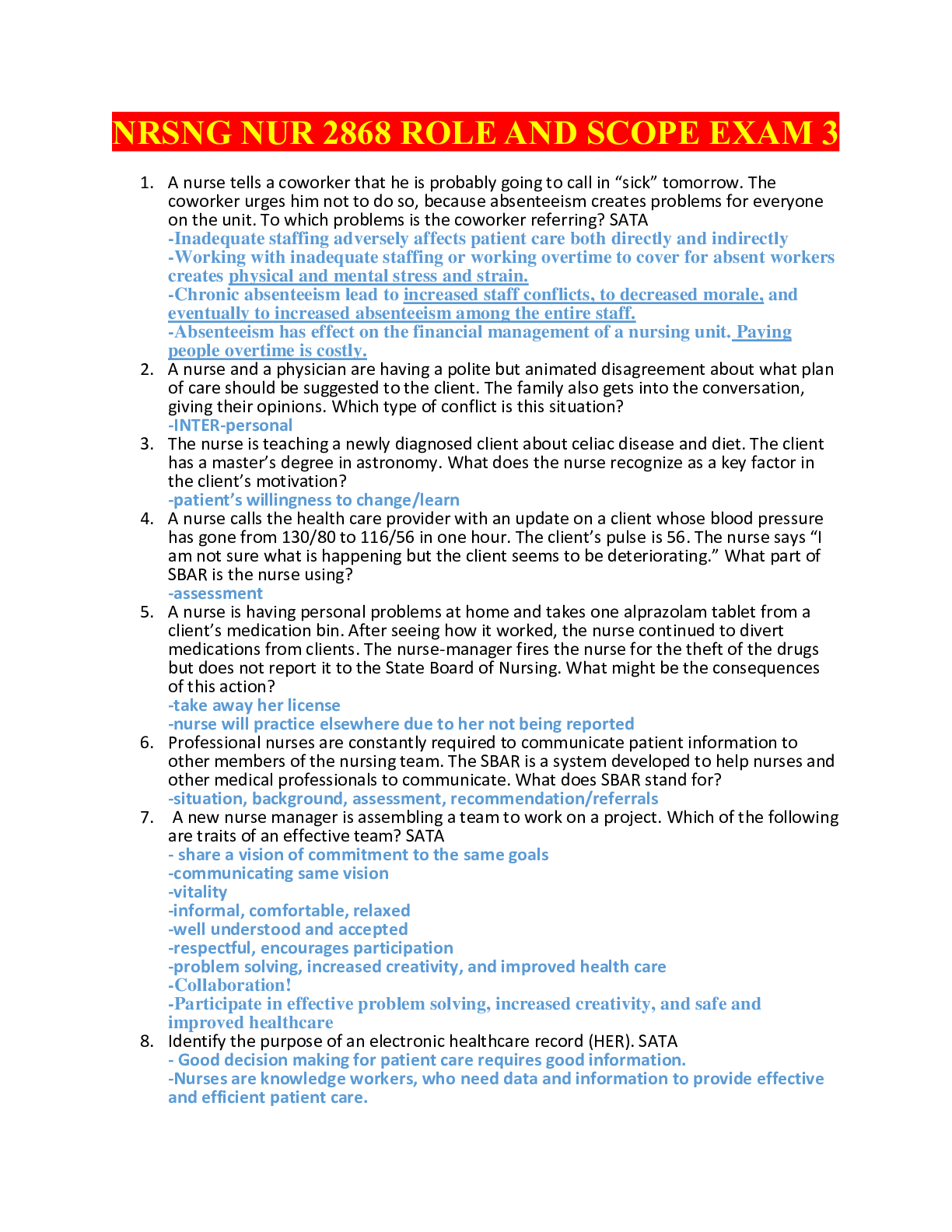

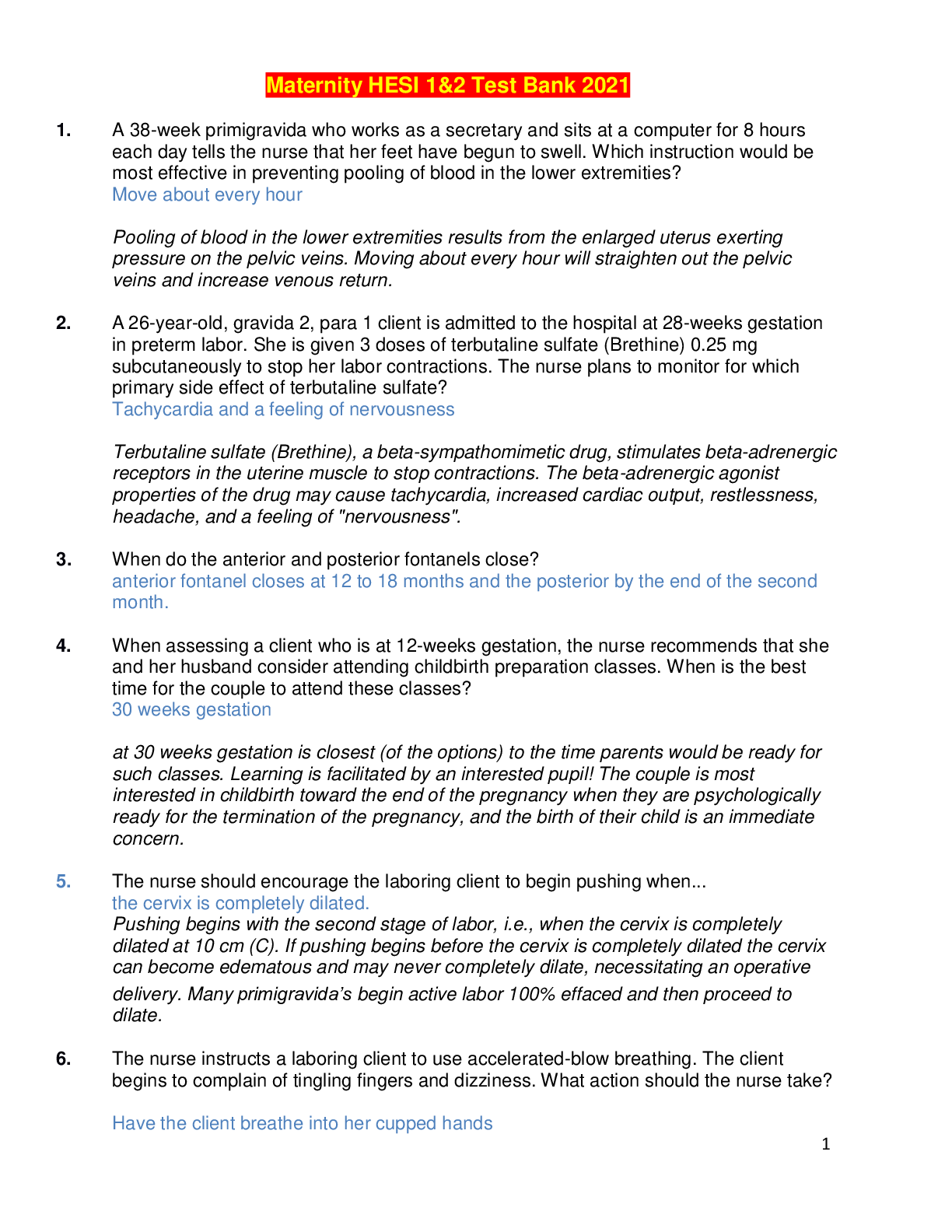
.png)
